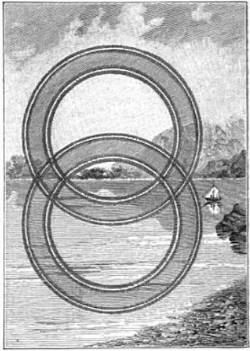
In Nature (January 23, p. 271) you give a letter from Mr. Scouller describing an interesting case of a rainbow, due to the image of the sun in water, which, with the ordinary primary and secondary bows, make up (there being no secondary to that formed by the reflected sun) the three which he saw. Here is a short account of what I saw long ago, almost in prehistoric times, in Scotland, where such sights ought, according to your correspondent, to be very commonly seen. I may mention that I saw at the same time, lasting some five minutes, eight well-defined rainbows of one sort or another.
In 1841, during the time of a long vacation party, spent at Oban, I walked out with my brother to Dunstaffnage, and we were on the top of the Castle, somewhere between 3 and 4 p.m., on a day in the middle of August. Not a breath of wind, bright sun over, I think, Lismore Lighthouse, dusky clouds all over Ben Cruachan and Conoll Ferry; the sea in the bay (bounded by Dunstaffnage in the west) as smooth as a pond. Gradually there appeared before us the astonishing sight of the aforesaid eight distinct rainbows, viz. primary and secondary ordinary bows; primary and secondary bows by reflected sun; primary and secondary bows formed by light from the real sun reflected from the water after leaving certain drops; primary and secondary formed by light from the sun reflected at the water, and, after leaving certain other drops, again reflected at the water. I have called the latter four distinct bows, because, although they looked like reflections of a solid set of four arcs, they were really formed by means of drops distinct from those which helped to make the first four bows. I append a sketch of what I saw.
— Percival Frost, letter to Nature, Feb. 6, 1890
